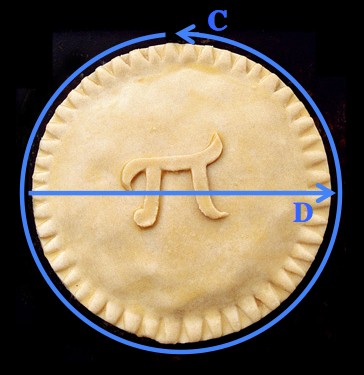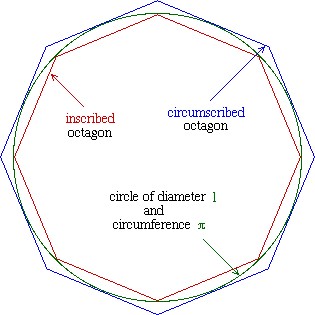Physicist: We sometimes get questions about physical constants changing, and those questions make sense because there’s no real reason for the constants to be what they are. But π is mathematically derivable; it kinda needs to be what it is. You can’t, through the power of reason alone, figure out what the gravitational constant or the speed of light are, but you can figure out what π is.

π is the distance around any circle, C, divided by the distance across that circle, D. All of the weird places that π shows up track back to this definition.
So this question is doubly profound! Unlike other constants, if π were different, then scientists (mathematicians especially) would continually have the sneaking suspicion that there’s something deeply, deeply wrong with the universe.
The definition of π seems pretty innocent (the ratio of the circumference of a circle to its diameter), but it shows up over and over in the middle of calculations from all over the place. For example, even though doesn’t, on the surface of it, have anything to do with circles, it’s still equal to π (there’s a loop floating around halfway through the calculation). A surprising number of calculations and derivations involve “running in a loop”, so π shows up all the time in electromagnetism, complex numbers, quantum mechanics, Fourier analysis, all over. In fact, in that last two, π plays a pivotal role in the derivation of the uncertainty principle. In a very hand-wavy way, if π were bigger, then the universe would be more certain.
Aside from leading almost immediately to a whole mess of mathematical contradictions and paradoxes, if π were different it would change the results of a tremendous number of (one could argue: all) calculations, and the fundamental forces and constants of the universe would increase or decrease by varying amounts. π shows up in way too many places to make a meaningful statement about the impact on the universe, one way or another.
Mathematician: The idea of giving π a new value of could be interpreted in a few different ways. For example:
1. That circular physical objects, as you make them progressively closer to perfect circles, approach a circumference to diameter ratio of something other than 3.14159… If this were the case, it might indicate something about the geometry of spacetime. If space is not flat, that can change geometric relationships. For instance, imagine drawing a circle on the surface of an orange. If we allow distances to be measured only along the orange’s surface (disallowing paths that penetrate the orange or go into the empty space around it), then the ratio of the circle’s circumference to diameter is no longer going to be π. It will, in fact, depend on the size of the orange itself. If our universe is not flat, but a curved surface, that could distort the geometric relationships that we measure on physical objects resembling circles.
2. That we change what we mean when we say π. Of course, π is just a symbol referencing an idea, so if the underlying idea that it references were to change, that would change the value of the symbol. But this is an extremely boring way to answer this question, reducing it merely to the redefinition of a symbol.
3. That we change which mathematical axioms we use. Most people think of math as a single, coherent set of rules. But when you get down to it, there are different possible sets of axioms that you can use to define mathematical concepts. By switching axioms it becomes possible to prove different things. If we were to choose a set of inconsistent axioms (i.e. axioms that lead to contradictions) then it would be possible to use this system to “prove” any mathematical statement true. In that case, you could show that π = your phone number, if you wanted.
If, on the other hand, you choose a set of axioms that are consistent with each other, but different than our standard math, you have to be more precise about what you mean by π. Usually, it makes no difference whether we define π to be the ratio of a circle’s circumference to its diameter, or whether we define it as
or
or
.
But when you start messing with axioms, it is going to affect what is provable, and therefore you have to be careful to specify precisely which definition you are using for π, since definitions that normally are equivalent using standard sets of axioms may no longer be. For some sets of axioms, there won’t even exist a mathematical entity that you reasonably could identify as being π.
Answer Gravy: There are a couple of ways to derive the value of π. Archimedes estimated it by sandwiching the circle between regular polygons that he could find the exact sizes of.
However, we can use methods younger than a few millennia to derive cute formulae for π.
Coming from another angle:
So,
Since arctan(0) = 0, if you plug in zero you find that C1 = C2, so you can get rid of them and . Now,
, so
. Therefore,
. That
is based on the definition of the radian, which tracks back to the circumference of the unit circle being 2π, but the fact remains:
and changing the value of π means, among other things, that this summation would need to somehow equal something different. But it is what it is.








45 Responses to Q: How would the universe be different if π = 3?